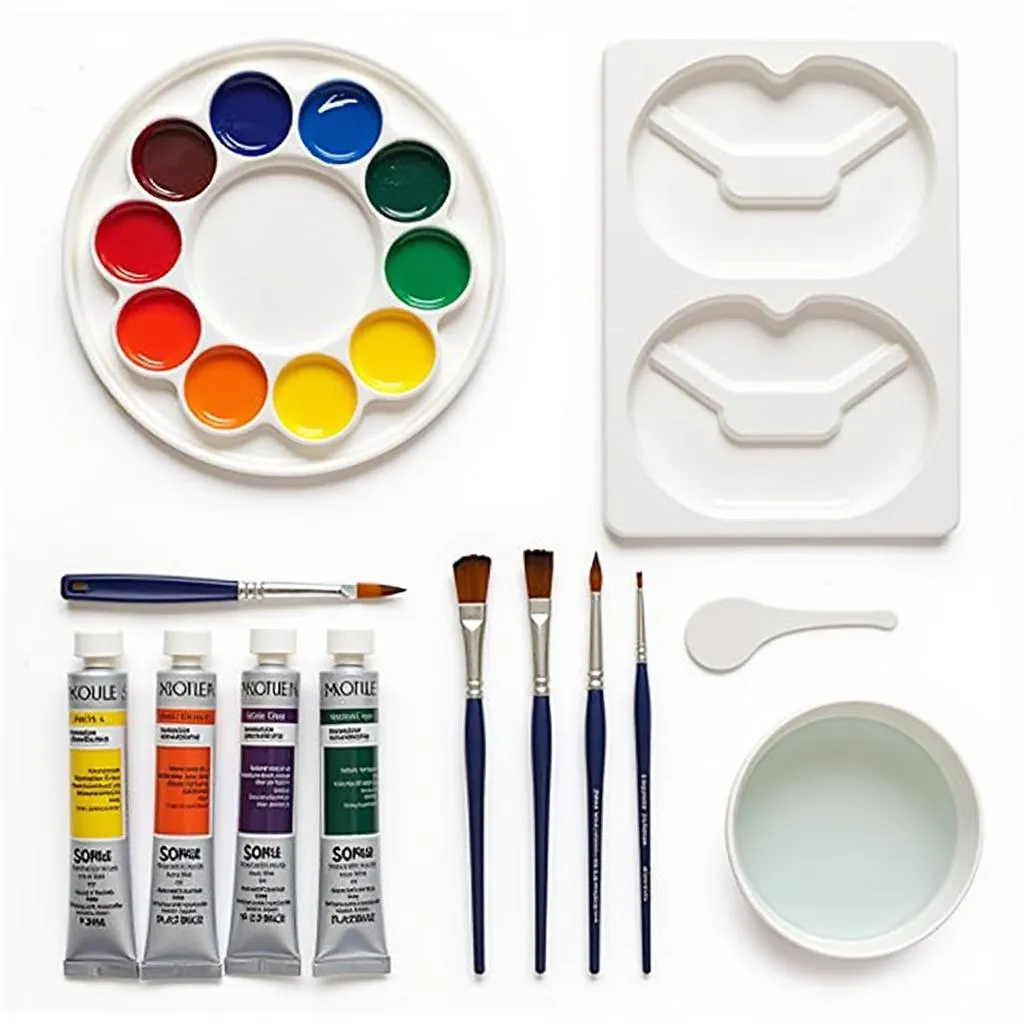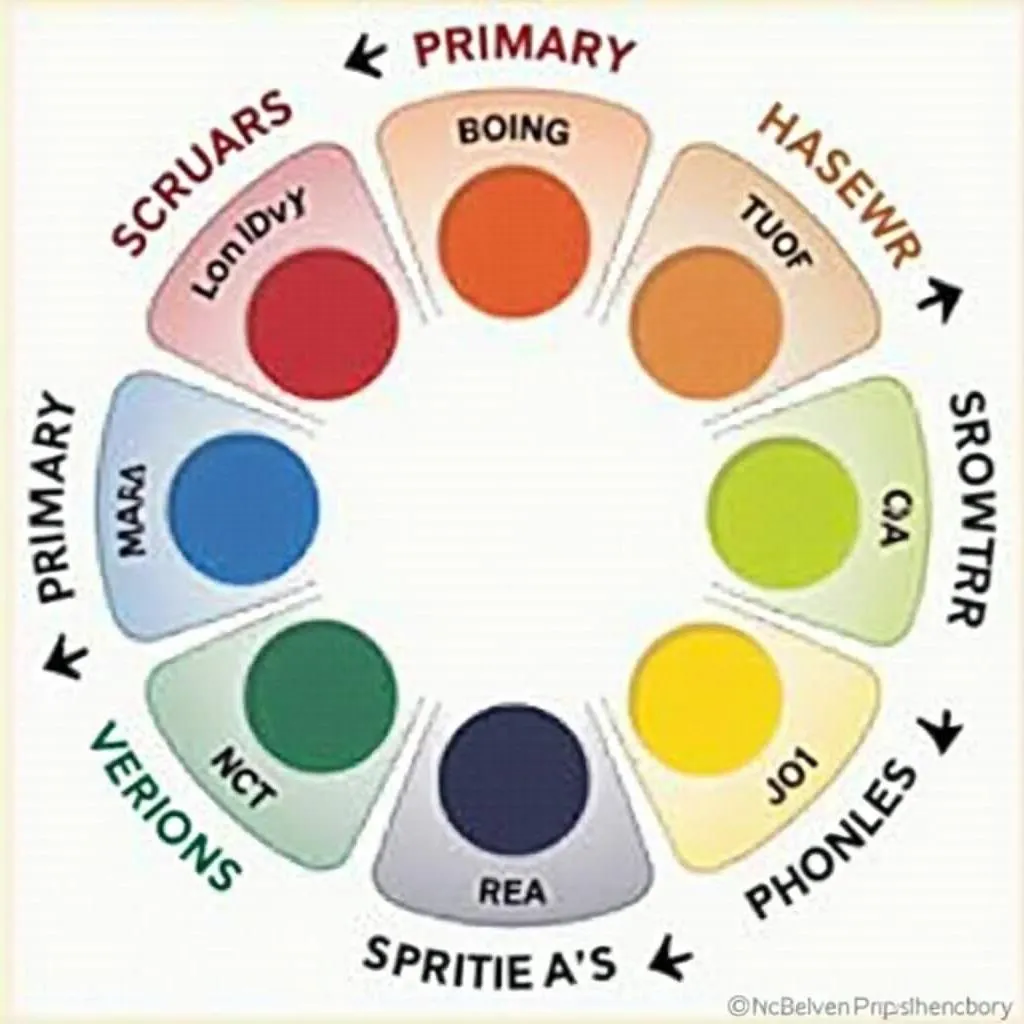Mixing colors for painting can feel like unlocking a secret world. It’s a fascinating process that empowers you to create an infinite spectrum of shades and hues, perfectly tailored to your artistic vision. Whether you’re a seasoned painter or a curious beginner, mastering the art of color mixing opens up a world of possibilities for your creative projects.
 Essential Color Mixing Tools
Essential Color Mixing Tools
Understanding the Color Wheel: Your Roadmap to Color Harmony
Before diving into mixing colors, it’s crucial to grasp the fundamentals of the color wheel. This invaluable tool, often referred to as an artist’s best friend, visually represents the relationships between different colors. Let’s break down the key components:
- Primary Colors: Red, blue, and yellow are the foundation of the color wheel. They’re called primary because you can’t create them by mixing other colors.
- Secondary Colors: Mixing any two primary colors in equal proportions yields a secondary color. Red and blue create violet, yellow and blue make green, and red and yellow produce orange.
- Tertiary Colors: Combining a primary color with an adjacent secondary color results in a tertiary color. Examples include red-violet, blue-violet, blue-green, yellow-green, red-orange, and yellow-orange.
Color Mixing Methods: Exploring the Techniques
There are several methods to mix colors, each offering unique effects and control over your palette.
1. Subtractive Color Mixing:
This method involves mixing pigments, such as paints or dyes. As you add more pigments, the mixture absorbs more light, resulting in darker colors. Here’s a simple guide:
- Start with lighter colors: Always begin with the lighter color and gradually add the darker one until you achieve the desired shade. This gives you more control over the final color.
- Mix small amounts: It’s easier to darken a color than to lighten it. Start with small quantities and gradually add more until you’re satisfied.
2. Additive Color Mixing:
Used primarily with light, this method combines different wavelengths of light to create new colors. For example, computer screens and televisions utilize additive color mixing.
 Mixing Acrylic Paints on a Palette
Mixing Acrylic Paints on a Palette
Tips for Successful Color Mixing:
- Use a limited palette: Starting with a limited palette of primary colors and gradually expanding can prevent muddy mixtures.
- Keep a color journal: Document your color mixing experiments by recording the colors used and the resulting mixtures. This serves as a valuable reference for future projects.
- Lighting matters: The lighting conditions in your workspace can significantly impact how you perceive colors. Natural daylight is ideal for accurate color mixing.
- Practice makes perfect: Don’t be afraid to experiment! The more you mix colors, the more intuitive it becomes.
Common Color Mixing Challenges and Solutions:
1. Achieving a True Brown:
- Problem: Mixing all the primary colors often results in a muddy brown, not a rich, natural one.
- Solution: To achieve a natural brown, start with orange and gradually add blue until you reach the desired shade. You can also experiment with complementary color combinations like red and green or yellow and purple.
2. Creating Vibrant Greens:
- Problem: Mixing blue and yellow can sometimes produce a dull or muted green.
- Solution: Start with a cool yellow, such as lemon yellow, and gradually add a small amount of blue, like phthalo blue, to achieve a vibrant green.
 Color Mixing Guide for Beginners
Color Mixing Guide for Beginners
Expanding Your Color Vocabulary:
Understanding color terminology can enhance your ability to describe and recreate specific colors.
- Hue: Refers to the pure color, such as red, blue, or green.
- Saturation: Describes the intensity or purity of a color. A highly saturated color appears vivid, while a less saturated one appears duller.
- Value: Represents the lightness or darkness of a color.
Conclusion:
Mastering the art of how to mix colors for painting is an ongoing journey of discovery. By understanding the color wheel, exploring different mixing techniques, and experimenting with various color combinations, you’ll unlock a world of creative possibilities, allowing you to bring your artistic visions to life with vibrancy and precision.
FAQs
1. What are the best paints for color mixing?
Acrylic paints are an excellent choice for beginners due to their quick drying time and ease of blending. Oils and watercolors offer unique properties and are suitable for different techniques.
2. Can I mix different brands of paint?
While it’s generally possible to mix paint brands, it’s best to stick with the same brand for optimal results, as pigment formulations can vary.
3. How do I create a neutral gray?
Mixing complementary colors, such as red and green, blue and orange, or yellow and purple, in equal proportions will result in a neutral gray.
4. What’s the best way to clean my brushes after color mixing?
Use soap and water to clean your brushes thoroughly, ensuring no paint residue remains. Proper cleaning will prolong the life of your brushes.
5. Where can I find more resources on color mixing?
Online tutorials, art books, and workshops offer a wealth of information and inspiration for color mixing techniques and theory.
Need further assistance with your painting projects? Contact us at Phone Number: 0373298888, Email: [email protected], or visit us at 86 Cầu Giấy, Hà Nội. Our dedicated customer support team is available 24/7 to assist you.

